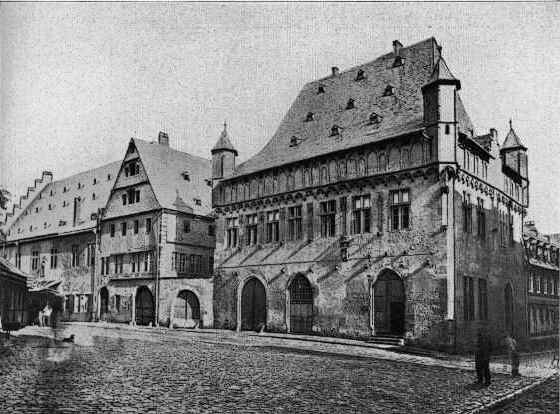Frankfurt
am Main - Leinwandhaus & Stadtwage, 1873

Frankfurt
am Main - Leinwandhaus & Stadtwage
1873
The Linen House (on the right) was built in 1399 on the Weckmarkt. It was of a type of large stone mansions (see also the Stone House) that could be found in the city at that time. It was first used as the city's weigh-house, then given over to the linen merchants. The building on the left, built 1502, became the weigh-house. It stood on the site of Frankfurt's earliest synagogue which had stood vacant since 1462 when the city's Jewish population was moved from the center of town to the vicinity of the Wollgraben. The weighing fees formed a significant portion of the city's income. The weigh-house was razed in 1874 and rebuilt as the City Archives (compare with the 1892 view). The gabled house between the weigh-house and the Linen House contained the freight transport authority.
Das Leinwandhaus (rechts) am Weckmarkt von der Stadt errichtet um 1400 im Typ der gro�en steinernen Stadth�user. Zuerst als Stadtwage bestimmt, dann aber schon mit Fertigstellung als amtliches st�dtisches Haus f�r den Frankfurter Leinwandhandel verwendet und bis ins 11. Jh. im wesentlichen zu diesem Zwecke benutzt. jetzt zum Historischen Museum geh�rig; die Stadtwage (links) 1502 errichtet an der Stelle der �ltesten Synagoge, die seit 1462 (zwangsweise Ansiedlung der Juden im Wollgraben) unbenutzt war. Die Wiegegeb�hren waren eine wichtige st�dtische Einnahmequelle. Die Stadtwage 1874 niedergelegt und von Denzinger das jetzige Archivgeb�ude errichtet. Das Giebelhaus zwischen Stadtwage und Leinwandhaus war das Bestatteramtsgeb�ude. (Beh�rde f�r Warentransporte.)